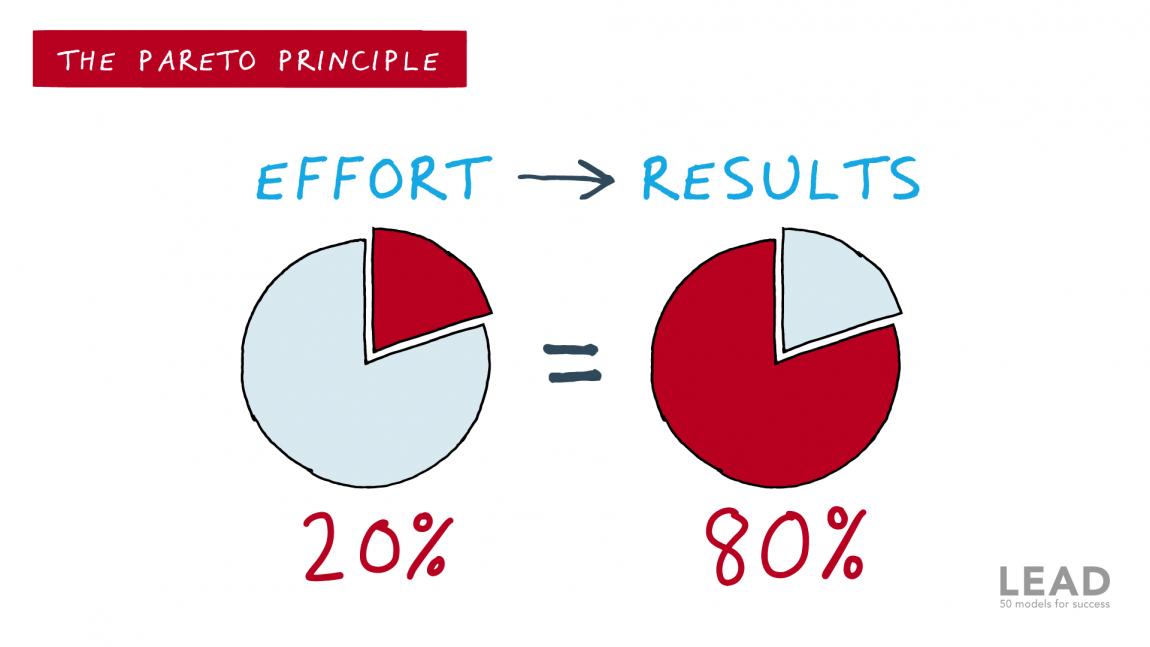I’ve been exploring a variety of mental models over the past few months as I study tools to improve decision making and strategies to increase the odds of achieving desired results. It turns out that many linear thought processes that come naturally to us are, in fact, inaccurate representations of how the world actually behaves. This is where applying mental models comes into play: when you intentionally push thoughts and ideas through a different filter, you can often sift out the most important components for consideration and discover game changing details that are hidden in plain sight.
How often is it possible to “do more with less”? I am keenly interested in paradoxical principles, particularly when applied to numbers, psychology, sociology, and neuroscience. I’ve already introduced several models of paradox including synergy arithmetic and the law of averages, and similarly the Pareto Principle – also commonly known at the 80/20 Rule, provides a ratio that defies our initial inclinations and linear logic.
The 80/20 Rule describes a frequently observed phenomenon that roughly 80% of effects are derived from 20% of causes. Cause does not directly equal effect.
The first researcher to uncover the 80/20 relationship was the namesake of the principle Vilfredo Pareto, an Italian economist who stumbled upon the pattern in 1897 when he found a consistent mathematical proportion appear while examining wealth and income within a population. He found that 20 percent of the population enjoyed 80 percent of the wealth, and when examined even further, 10 percent would have 65 percent, and 5 percent would have 50 percent. He kept finding the ratio repeating itself, leading him to conclude that the distribution was predictably nonlinear, regardless of time periods or locations.
The Pareto Principle is counterintuitive; to assume cause equals effect is a 50/50 fallacy. Our tendency toward linear thinking is often an oversimplification of reality, where cause and effect rarely demonstrate equality.
The indirect correlation between input and output reveals that all inputs are not created equal. The Pareto ratio is variable; it could be 70/30, 90/10, or 99/1 – in fact, the two numbers do not even have to add up to 100 because they reflect completely separate measures. The ratio could just as well be 60/3 if 60% of output comes from 3% of input. The 80/20 ratio is visually clean and complementary from a mathematical perspective, but actual arithmetic is loosely applied here. Regardless of how you slice the pie, the Pareto Principle’s key takeaway is that effects are predictably unbalanced in relation to cause.
Examples of the Pareto Principle include:
- 80% of sales come from 20% of clients
- 80% of performance comes from 20% of employees
- 80% of crimes are committed by 20% of criminals
- 80% of software glitches are caused by 20% of bugs
- 80% of complaints come from 20% of customers
Pareto’s discovery became more widely observed in the 1950’s when two separate individuals expounded on the ratio. The “vital few” vs. the “trivial many” are terms that Joseph Juran popularized in his approach to improve high product quality. About the same time, George Zipf used the “Principle of Least Effort” to describe the 80/20 ratio that appeared in his observations that resources had a tendency to be arranged in ways that minimized work.
When you leverage the potential of a small selection of inputs, you increase your odds of making a significant impact. Using the process of substitution, you can identify inputs that have weak effects, and either eliminate altogether or use them sparingly. Then, you can reallocate resources and shift focus towards super-productive inputs that produce the greatest value.
The Pareto Principle highlights the importance of taking a strategic approach to prioritization and delegation in order to optimize efficiency and time management. What are the 20% elements where you can focus your efforts in order to achieve 80% of the results?
This is yet another instance where the mental model of The One Thing can be applied: when you take the time to identify the most important component to get right and focus your energy there first, the remaining pieces will either fall into place or become unnecessary as a result. Don’t exhaust your time and energy on trivial pursuits; instead look for that lead domino that will precipitate a chain reaction. Seek out sources of momentum and ways to unleash potential, and you will likely be astonished by the ratios that result.

